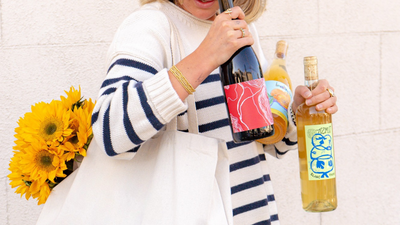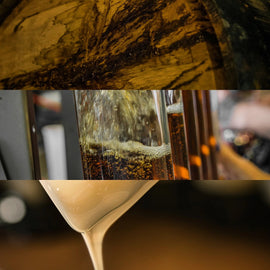Nestled in the south, surrounded by the Black Forest Range to the east and running along the Rhine River from the French/Swiss border to the west, the state of Baden-Württemberg is one of the sunniest regions in Germany, consistently producing quality red wines for over a millenia. Until recently, Germany was known mostly for its age-worthy white wines, both sweet and dry, but with climate change, the country is increasingly recognized for its dry reds. These two regions, with their high elevations and warmer climates (relative to the rest of Germany), are similar to the Loire Valley, Alsace, and Champagne, and have been leading the charge in this regard for decades. Both produce a greater amount of red wine than most German regions, with Baden having the largest amount of red grapes planted. This is mostly Pinot Noir, but with the higher temperatures, some Syrah and even Cabernet Sauvignon are able to ripen. Württemberg, for its part, is planted with around 70% red wine grapes, predominantly the lighter bodied Schiava grape, known here as Trollinger, which migrated from its home in Northern Italy in the 14th century.
While wild grapes have been growing along the Rhine River Valley since prehistoric times, viticulture came to Germany with the Romans in the first century. They planted along the steep slate and limestone-rich soils of the Rhine and Mosel in order to provision far-flung imperial outposts battling local Germanic Tribes. When the Roman Empire fell, the Catholic Church became the stewards of these vineyards. First Benedictine and then Cistercean monks planted vineyards and meticulously documented the best areas for growing grapes. Under the reign of Charlemagne in the 8th century, these monasteries became the hub of wine culture in the country as wine was found to be a safer alternative to the often polluted water. Pinot Noir, here known as Spätburgunder, is said to have arrived in Baden around the late 9th century, via German emperor Charles the 3rd, who brought it from north-eastern France and planted it near Lake Constance, just above the Swiss-German border. Known as “Clevner” in Baden for hundreds of years afterwards, the grape spread further afield as nuns and monks fanned out from Burgundy to establish convents and monasteries.
Wine remained a staple in Germany through most of the Middle Ages, with four times as much land planted to vine as there is today. It wasn’t until the 16th century that beer started its ascent in the country, with more and more land previously used for winemaking transitioning to food crops. This shift was exacerbated by the ravages of the Thirty Years’ War as well as the Protestant Reformation, leading to the dissolution of monasteries where winemaking knowledge was concentrated. These factors were compounded by the Little Ice Age, a period of cold, dry temperatures starting in the 1300s that reached their coolest around 1650, and led to widespread famine due to crop failure. Napoleonic law splintered vineyards even further, leading to a rise in cooperatives in these southern regions. After World War Two, the regions, which had been independent German states, were merged and split between French and American occupation. For most of the 20th century, the local wines suffered from the same poor reputation as most of Germany’s output, producing light, semi-sweet and undistinguished bottlings, apart from a few producers. This started to change towards the end of the century with more vintners focusing on quality dry wines. These days the wines of Württemberg are good enough to garner recognition despite the fact that most never leave Germany, and many are consumed within the state itself. Württemberg and Baden are both areas worth keeping an eye on as our selections this month demonstrate.
Prost!
Justin Malesheetz - Fillmore Wine Buyer
|
2022 Weingut Siegloch Muskateller |
|
|
Region / Country of Origin: Winnenden, Württemberg, DE |
About the winery: Initially established in 1993 with the merging of the vineyard holdings of the Klöpfer family based out of Winnenden and the Siegloch family of nearby Cannstadt. Since their father's death in 2014, the winery has been run by brothers David and Markus Siegloch. They have focused on sustainable viticulture and a hands-off approach in the cellar. About the winemaking: 100% Gelber Muskateller from sustainably farmed estate vineyards planted on steep pebble sandstone soils at elevations up to 1400ft that undergoes ambient fermentation and is aged on the lees in stainless steel for about 6 months before being bottled without fining, making this wine vegan. Tasting Notes: Pale straw in the glass with a bright perfumed nose with aromas of elderflower, limes, stone fruits, and lychee. Bright with vibrant acidity, lightly effervescent, light-bodied, and just off dry at 11.2 g/L of residual sugar (dry wines can be anywhere between 0 and 10 g/L of residual sugar), this wine is perfect for warm weather with its flavors of white grapes, fresh limeade, and elderflower and a long fresh finish. |
|
Winemaker: David Siegloch |
|
|
Price: $24.99 btl/$269.89 cs |
|
|
Suggested Food Pairing: Fresh fruit tart, Salmon with a ginger glaze, seafood curries, spicy katsu sandwich |
|
|
2021 Weingut Schloss Ortenberg “Granit” Spätburgunder |
|
|
Region / Country of Origin: Ortenberg, Ortenau, DE |
About the Winery: This historic vineyard surrounding Ortenberg Castle on the steep granite slopes on the edge of the Black Forest was among a handful in Germany that was publicly owned and was the largest communal winery in Germany. Originally an offshoot of the Saint Andreas Hospital founded in 1300 by the citizens of Offenburg that sustained itself from donations, winemaking was started in 1407 after the donation of the first vineyard. This was merged with another municipal winery in the area, the Schloss Ortenberg wine-growing experimental estate that was formed in 1950 to revive the winemaking tradition of the former castle owners. The estate was taken over in 2021 by hotelier Thomas Althoff, who has invested heavily in the vineyards and under whose watch the vineyard has gained wider acclaim not only in Germany, but on an international stage. The winery continued to be managed by Ortenau native Matthias Wolf, who worked in New Zealand and South Africa before returning to the region he was raised in. The vineyards are cultivated sustainably, utilizing techniques such as pheromonal interference instead of insecticides, organic fertilization, and composting, as well as being innovative in regard to enclosure by eliminating cork in 2004. About the winemaking: 100% Pinot Noir from 25-year-old sustainably farmed vines planted on steep west-facing granitic soils that were hand harvested and partially destemmed before undergoing a 4-day cold maceration to extract more color and aroma compounds before fermenting in stainless steel tanks for 7 days. The wine undergoes malolactic fermentation and extended lees contact and is then aged for 18 months in a combination of new casks and used barriques. Tasting Notes: Pale garnet in the glass, this wine is perfect for those who like their pinots on the earthy side. Almost syrah-like on the nose with a mix of smokey peppery aromas intermingled with notes of black cherry, crushed rocks, graphite, menthol, and oolong tea. The palate is equally brooding with moderate tannins and racing acidity framing flavors of dark cherry, pomegranate, raspberry jam, dried violets, and truffles with a dry earthy floral finish. |
|
Winemaker: Hanspeter Rieflin |
|
|
Price: $24.99 btl/$269.89 cs |
|
|
Suggested Food Pairing: Smoked cheeses, game, braised vegetables, mushroom risotto, Jägerschnitzel, limburger, bratwurst
|
|





